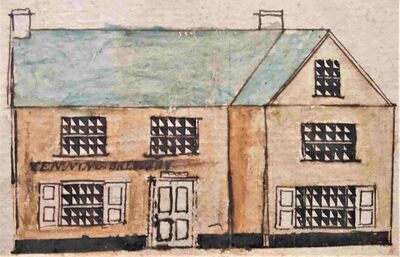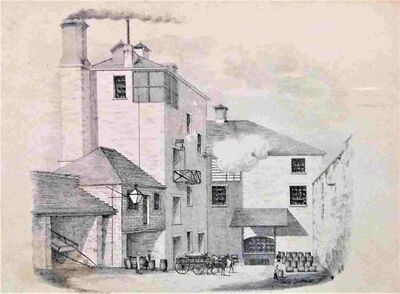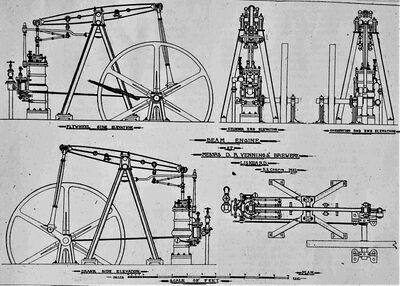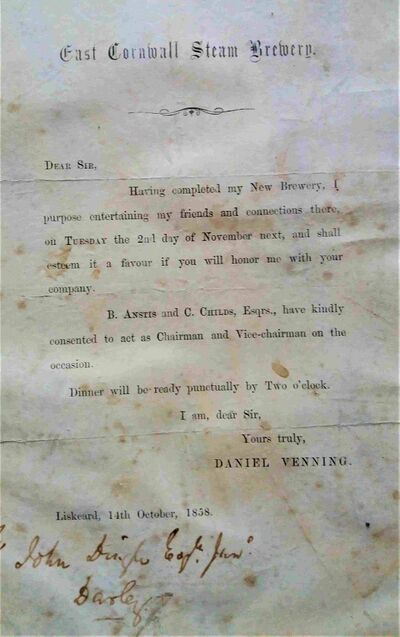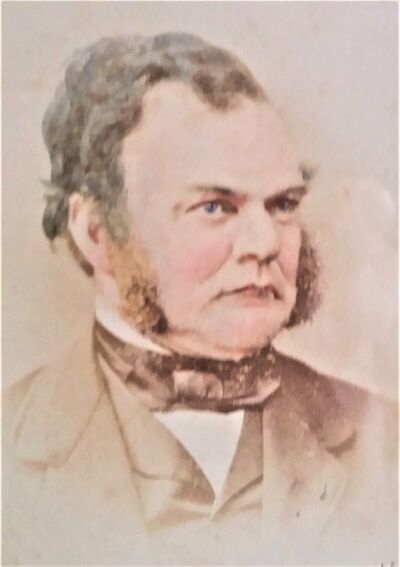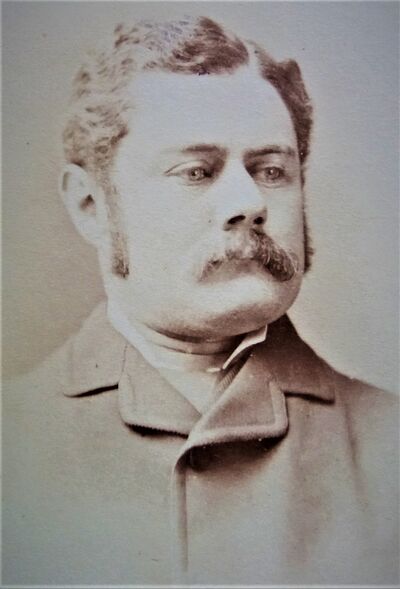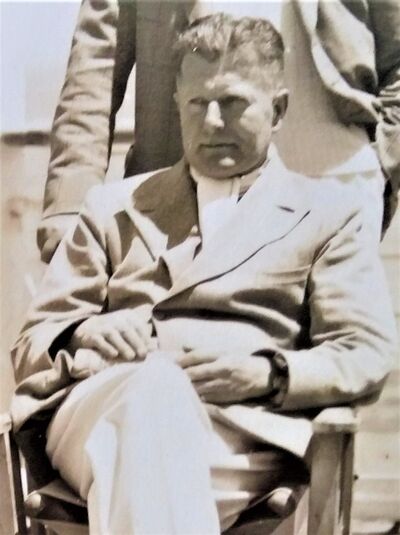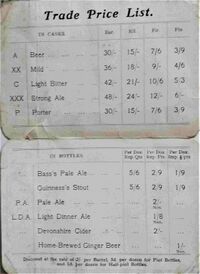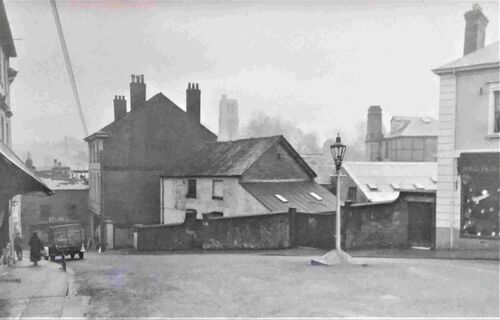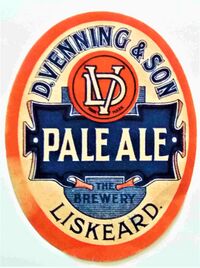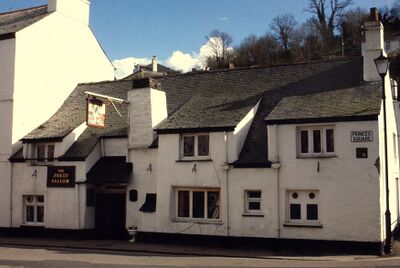Venning & Sons - A History
East Cornwall Steam Brewery/ D Venning & Son Ltd, Liskeard, Cornwall
A short history by Philip Venning, great great great grandson of Edmund Venning
It is a bit of a miracle that this small Cornish brewery survived for about 130 years. A drastic modernisation and expansion in 1858 came at the worst possible time. A previous boom in the local mining industry collapsed. Teetotalism became more entrenched, and the sons of the family went into the professions with little interest in the business. The story starts with Edmund Venning, 1783-1842, who was apprenticed as a maltster to his father George at the family farm and maltings at Trebant Barton, Altarnun, Cornwall. When the property was put up for sale in 1816 the malthouse was “sufficiently extensive for the making of upwards of 1000 bushels of malt annually,” according to the sale particulars.
At some point Edmund moved to Liskeard and set up as a maltster and brewer in Bay Tree Hill, possibly after the attempted sale of Trebant in 1816, his marriage that year in Altarnun, and his father’s death in 1817.
The Brewery History Society records state that the Liskeard brewery began in about 1773 and was acquired by Edmund Venning in 1830. The earliest date we can associate with Edmund is 1828, based on an envelope of that date addressed to him in Liskeard which was a receipt for hops. But we know he owned the brewery by 1832.
On 13th September 1832 a newspaper article described a fire in the malt house of Mr Edmund Venning of Liskeard. “The flames were spreading rapidly towards the dwelling house, when the two engines arrived which very soon…got the flames under, and in about half an hour after their arrival, the flames were completely extinguished.” It was helped by the fact that there was well on the site. (Advertiser for Devon, Cornwall, Somerset and Dorset, 13th September 1832)
On 31st March 1836 at Cornish Assizes Messrs Wright, brewers of Bodmin, successfully sued Edmund Venning, “brewer and maltster of Liskeard”, for slander for having claimed there were toads in his beer. He was fined £5.00. And in 1839 Robson’s Directory lists him as a brewer and maltster. It seems likely the brewery was a fairly small scale operation.
In 1845, three years after Edmund’s death, the brewhouse, malthouse and attached Union Inn were put up for sale. Interestingly the inn, malthouse and brewhouse had recently been “rebuilt”, bearing in mind that Daniel Venning opened a “new” brewery on the site only 13 years later. The brewery can’t have sold. The inn was tenanted, but was presumably a separate operation from the brewing and malting on the same site.
Cornwall Royal Gazette. 15th August 1845
Edmund died in Liskeard on 6th October 1842, and left a will listing his possessions. The principal freehold property is “my dwelling house and malthouse and brewhouse and stable and cellars situate in Bay Tree Hill”. This passed to his son Daniel Venning, 1818-1894, who was presumably already working in the family business. He also left a freehold public house in the parish of Linkinhorne “well known by the name of Upton” to his daughter, Anna Maria. He also left the public house, stable and coach house called the King’s Arms, in Liskeard, to his younger son John (which was mortgaged). Numerous references to The King’s Arms appear in local newspapers as it is the place where auctions were held and details of sales elsewhere were available. It was demolished to make way for two houses, a savings bank and lecture room possibly before or soon after Edmund’s death.
Believed to be the original Bay Tree Hill inn, malt house and brew house
In 1847 Daniel Venning married Amelia Willmott Beal. The Beals were a well educated family, with two of Amelia’s distinguished brothers featuring in the Dictionary of National Biography. This would have enhanced the status of the Vennings, but would also help explain why Daniel’s three sons all trained for the professions.
THE EAST CORNWALL STEAM BREWERY
The 1851 Census shows Daniel Venning as a maltster and brewer employing four men. It was in 1856 that he began planning his new brewery. According to an article in the West Briton of 5th November 1858 he first visited “most of the great breweries in the kingdom” to make sure he adopted all the best practices. The cost was about £3,000. It would be operated by a single steam powered beam engine, and covered 4,000 sq ft. It was initially called the East Cornwall Steam Brewery, later D Venning and Son.
The brewery, with somewhat exaggerated scale.
The 12 hp beam engine started life at the Mary Ann Mine near Menheniot in 1840 before being moved to the brewery. It was measured and recorded in 1931 and was still in place in the 1950s.
The “New Brewery” was opened on 2nd November 1858 with a formal dinner at which 250 people were present. They included “the greater portion of the respectable inhabitants of the town”, according to The West Briton .The brewery was decorated with flags and evergreens, there was a gallery for the ladies and a band played.
By the 1861 Census the brewery was employing six men and one boy. As it turned out it was the worst possible time to open what was quite a substantial operation. The Cornish mining economy, having been booming, was in trouble and in Liskeard the teetotal movement was gaining political strength.
In the 1850s Liskeard, an ancient stannary town, was developing as a thriving Victorian commercial centre partly because of a boom in the local mining industry. But in 1866, eight years after the opening of the brewery, the world price of copper collapsed. “The impact on the town was as dramatic as the earlier boom years of the 1840s.” (Liskeard and its People, by Bernard Deacon. 1989). The copper and lead miners in the neighbouring villages emigrated, and there were many bankruptcies in the town, including publicans. The population of Liskeard dropped by a quarter in the 1870s and 80s, and it reverted to being a centre of a farming community.
In 1847 there had been at least 16 inns, pubs, and beer houses within the parish boundary. An active and powerful Temperance Society pressed for new restrictions on the pubs, which by the 1860s had become a live political issue. This was in part because of the strength of Methodism. Daniel Venning and the brewery were very much caught up in this.
Daniel Venning
Even though Daniel was a lifelong Methodist himself, he came into increasing conflict with supporters of the temperance movement, including fellow Council members, as a result of his occupation. In 1871 with much rejoicing they succeeded in ousting him from his Council seat. However he was back again three years later. Not surprisingly considerable opposition to the brewery remained.
It was in that year that Daniel Venning and his brother John both became agents of the Licensed Victuallers Tea Association. This odd sounding body had been set up in 1867 because grocers had started selling wine. So agents of the Association sold packets of tea and coffee.
The natural person to take over the brewery was Daniel’s eldest son, Edmund, who was born in 1849. But he was set on a medical career, studying at University College Hospital, London, qualifying in 1867. He was awarded a silver medal for midwifery, and “first certificate of honour”. But it was not to be.
Edmund Venning in August 1867 having just completed his medical studies
At this point he was required to return to Liskeard to help run the brewery which he did, by tradition very reluctantly, for the rest of his life. It was also the worst possible time for the brewery for the reasons given above. One can imagine Edmund’s lack of enthusiasm for the business. It seems he devoted much of his time to Masonic interests with the brewery very much in second place. He died in 1904 aged only 54. The brewery passed to his oldest son, Daniel Riley Venning, 1882-1956.
Venning brewery bottles
Edmund Venning
Riley Venning
Riley Venning, as he was known, had already started helping with the brewery shortly before his father’s death and then became Managing Director. The other directors were his mother, sister, and younger brother Gilbert. Gilbert initially also worked for the brewery but later moved to E. & H. Kelsey Ltd, brewers of Tunbridge Wells, becoming chairman in 1949.
The brewery, Bay Tree Hill. The two storey building in the centre might be the remains of the building in the coloured illustration above with the words Venning Brewery on it. In the 20th century the brewery supplied 11 tied houses and several free houses in and around Liskeard and Looe. Two well known tied houses in Looe were The Salutation, home of the Shark Angling Club of Great Britain (East Looe), and also The Jolly Sailor (West Looe). The other tied houses were:-
- The White Horse
- Albion Inn
- Victoria Inn, Liskeard
- The London Inn, St Neot
- Caradon Inn, Upton Cross
- Manor Inn, Rilla Mill
- Fishermans Arms, East Looe
- Bullers Arms, East Looe
- White Hart, Menheniot.
The Jolly Sailor, Looe
In 1920 the brewery transferred from horse drawn deliveries to lorries and sold off two cart horses, two wagons, various carts and other accessories. From Victorian times the railway station in Liskeard allowed deliveries over quite a large area, including the fishermen of Looe who used to swear by pilchards and “a pint of Danl Venning”.
In 1923 there was a serious industrial accident at the brewery. Three workmen, enamelling the inside of a large vat, were overcome with fumes and two were found unconscious at the bottom. Fortunately they recovered in the cottage hospital.
Though the brewery continued as a relatively small scale operation, minor improvements took place. A new bottle store was built in 1936. A year later the brewery invited tenders to construct a block of three shops with flats over in Bay Tree Hill, presumably on land already owned by the brewery.
Tragedy struck on 18th November 1942. The brewery was all but destroyed in a devastating fire. It was a pure accident and unrelated to enemy action. In the early afternoon smoke was seen coming from the building: the boiler house was on fire. “A great sheet of flame rose high in the air and clouds of steam issued from the exploding bottles of beer and spirits”, according to The Western Morning News. Volunteers helped removing stock from the blazing building. Three fire brigades fought the blaze. One of the fireman fell from the roof as it collapsed but fortunately broke no bones. By 5pm the fire was under control, but thousands of pounds worth of damage had resulted.
The burnt out brewery
In time the premises were repaired and rebuilt but all brewing had come to an end and was not revived. From then it simply became a bottling plant with the wine and spirit business on the side.
Riley Venning continued running the brewery after the war. But his only son, Roger, had died aged 36 in 1953. With no one to take on the business, which was only a shadow of its pre-war state, he must have felt there was little future for it. In December 1954 it was sold to Watney Mann Ltd.
Watneys sold it in September 1962, apparently affecting 40 employees [Cornish Guardian 20th Sept 1962].
Since then it has been partially used, rather unsatisfactorily.
A Postscript by Peter Goodson, Director/Co Secretary, Fosters/Courage UK
I read with interest the article on Vennings by Philip Venning.
As the last person to have anything to do with this company I thought that he might like to know what happened to it after it was acquired by Watneys.
The company, No 206849 was incorporated on 25th June 1925. The shares were acquired by Watney, Combe, Reid & Co. Ltd on 1st January 1955. The name of the company was changed to Special Beer Distributors Ltd on 10th June 1982 and again to The Special Beer Company Ltd on 22nd June 1983.
However, I could find no evidence of it having traded during this time and when the company was transferred to Fosters/Courage on 28th March 1991 along with the Grand Met brewing business it was listed as dormant. My job was to get rid of unwanted companies and I can confirm that it was struck off on 24th April 1995.


